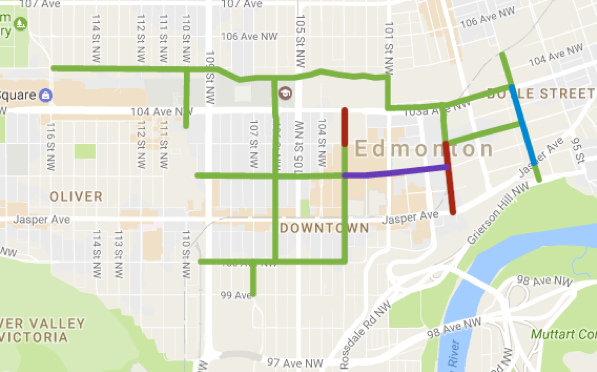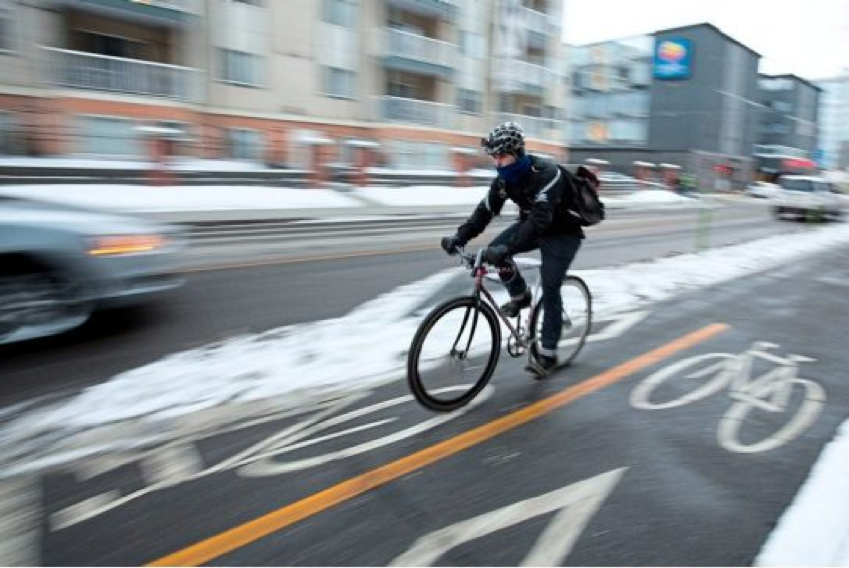Defending Bike-Lanes at Your Family Dinner Parties - A Comprehensive Guide
/Over the winter break, I attended numerous family events. Like most university students at these events, my relatives always ask me questions about my school, such as what classes I’m in, what I’m learning, what I want to do with my degree. However, because I study urban planning immediately after these formalities they proceed to grill me on contentious issues occurring in the City of Edmonton. Often they tell me why their opinion on the particular issue is correct and why the City of Edmonton is not adequately addressing the problem. Next, they tell me how it is my job to take their specific wishes on this particular issue to the city council and instantly enact the change they want to see. Over the years I have become accustomed to these sorts of conversations. Mainly I rationalize the planning process and attempt to demonstrate that the issue is not as black and white as they may see it.
Bridget Jone's Diary - Universal Pictures, 2001
This particular year, the hot topic was the recently constructed downtown bike lanes. At every single family event, I had at least one family member approach me and rant about why the new bike lanes were a mistake for one reason or another. While I brought up numerous points to defend the bike lanes, I realized my support for them could be enhanced by doing some research into the details of the Edmonton bike lanes and cycling infrastructure in general. Motivated by my ignorance, I constructed this article as a guide for fellow planning students and cycle-enthusiasts who want to argue against five of the most common criticisms of bike-lanes of at dinner parties. After reading this guide, you will be able to effectively defend the bike lanes against numerous criticisms that I encountered and demonstrate how the City of Edmonton’s downtown network of bike lanes are a worthwhile investment and beneficial to the City of Edmonton and its citizens.
Complaint 1: Utilization.
“Those new bike lanes are a waste of money, I never see anyone biking in Edmonton.”
In the past, all Edmonton bike lanes have had no physical barriers between cars and bikes. They have been merely painted lines or pictures of bikes on the road, called sharrows. Historically, in all cities where sharrow lanes have been implemented, the lanes have been less effective at increasing bicycle ridership and safety for the cyclist.
Downtown Bike Lane Map - Metro News
The City of Edmonton also wants to ensure the bike lanes are useful and if they attract users. That is why they have partnered with the University of Alberta to monitor bike usage before and after the introduction of the bike lanes. Before the network being completed, 2,454 cyclists were riding downtown on May 31, 2017. On June 30, after the installation of the bike lanes, the number of cyclists nearly doubled and jumped to 4,711. This jump in the number of cyclists when the infrastructure is improved or expanded (or in Edmonton’s case created) is a common correlation found in the academic literature on bike lanes amongst cities of various sizes and climates (including winter cities). For instance, Calgary implemented a similar downtown bicycle network in 2015 and has seen a significant increase in ridership. In other words: if you build it (with quality), they will come.
Complaint 2: Price.
“I can’t believe City Council is wasting so much money on bicycle lanes when they could use the money to fill potholes.”
The total cost of creating the bike network was 7.5 million dollars for the 7.8 kilometres. Admittedly this is a steep price for a new program. However, of the cost, over half of it was for updating downtown signal lights that were already overdue for replacement.
Furthermore, this cost is pretty minuscule in comparison to what is spent on cars every year. For instance, the 2017 budget for roads in Edmonton was 115.74 Million dollars.
Finally, bike lanes have been found to require less maintenance and last longer than roads do.
Complaint 3: Congestion.
“It messes up traffic and takes up too much road space that is needed downtown.”
Yes, the bike lanes do in fact take away parking and road space. However, there is a lot of research to reinforce their placement, and they are not as intrusive to downtown traffic as one might think.
The City of Edmonton for many years has wanted to increase the number of cyclists in the city and has made numerous documents aimed to increase ridership in including the 1992 and 2009 Bicycle Transportation Plans. The City of Edmonton confirmed their decision to expand cycling infrastructure in the downtown area due to their research indicating prior to the addition of the downtown bike network that citizens living within a twenty-minute ride of downtown were six times more likely to bike to work. Furthermore, the levels of cyclists downtown have been steadily increasing before the installation in 2017.
In terms of specific placement, the City of Edmonton put extensive research into where the bike lanes should be placed. They prioritized roadways that were found to be under capacity and have studied traffic patterns before and after their implementation to identify points of congestion. Thus far, roads have not seen a major increase in congestion after the bike lanes were implemented. Furthermore, in numerous interviews City of Edmonton representatives have noted that the current location of bike lanes are not necessarily permanent, they could be moved if their location is deemed ineffective or a significant hindrance to downtown.
Additionally, if there is no dedicated space for cyclists, the bicycle must travel and share the same space devoted to the cars. While this solution allows for more lanes for either traffic or parking, this also slows cars down as they must drive behind cyclists.
Recent and future downtown developments such as the ice district, the new Royal Alberta Museum and a massive increase in the number of condos means more people are coming downtown to live, work and play. Downtown Edmonton already faces congestion. However, there is no way to expand the current road network. Therefore, diversification will be the key to minimizing the increase in downtown congestion. Every biker represents a potential car coming downtown and taking up parking space. By providing a safe, accessible alternative to driving on residential and under capacity downtown roads, it can help lower the number of people driving into downtown each day. This will open up more parking availability and reduce congestion on arterial roads into downtown for those that still rely on private automobiles.
Finally, biking on streets with separated bike lanes have been found to reduce the risk of injury by ten times compared to biking on busy streets next to parked cars. This massive increase in safety is simply worth the road space it uses.
Complaint 4: Confusion.
“The bike lanes are confusing, I don’t know how to use them or how to behave around them as a driver.”
Yes, the bike lanes do take a bit of getting used to. However, the city has put in extensive signage and very visible green paint to show all road users how to behave around this new infrastructure. However, realistically it will take time for both drivers and cyclists to get used to them.
Downtown Bike-lanes and Extensive Signage - John Robertson, CBC
The City of Edmonton has created a set of guidelines online to help both automobile users and cyclists learn how to navigate the network with safety and ease. When the bike lanes were first open, the City positioned “street-team educators” at peak hours to help cyclists obey traffic lanes and follow safe practices in the bike lanes. Furthermore, the city hosted many public engagement events before the construction of the bike lanes and after their introduction. As well, there is an online survey currently open to members of the public to tell the city how they feel about the bike network.
These bike lanes were in no way a sporadic decision. They are a product of the City of Edmonton’s 2009 Bicycle transportation plan that outlines how they would study ridership, implement plans, and why they felt increasing cycling infrastructure, particularly in the downtown area, should be completed.
Complaint 5: Snow Removal.
“Why do bike lanes get plowed before roads in the winter? This will delay plowing elsewhere!”
Downtown Winter Bike-Lanes - Kevin Tuong
If anyone has ever biked on a snow day, you will discover very quickly that snow affects a bike much more than a car. Snowy bike lanes will cause spills, collisions, and deterrence of use. Therefore, to maximize use and safety and due to the increased impact snow has on bikes, they must be cleared as soon as possible.
Clearing the mere 7.8 km of bike lanes (that are only about 4m wide) represents a minuscule amount of the time and resources required to clear the all the City of Edmonton roads in the winter.
Additional facts to tell your stubborn Uncle:
- Pollution: Transportation is one of the most significant sources of air pollution in Canada by increasing active transport we are helping lower this pollution and creating a more sustainable city.
- Public health: According to stats Canada roughly ⅔ adults in Canada are obese. Increasing the cycling infrastructure gives people the opportunity for free, safe physical activity and that can create a healthier population and help to reduce the impact of obesity on the healthcare system.
- Downtown Revitalization: Biking can be pursued for function or recreation. The bike network can be used as a free leisure activity and way to explore downtown Edmonton.
- Accessibility: Studies have shown separated bike lanes help attract those who would otherwise feel unsafe to the cyclist. Cycling represents a cheaper way of getting downtown than driving or taking transit for those that may struggle to afford either of these modes.
- All other major Canadian cities have bike lanes (including Calgary), and people even use them in the snowy cities like Montreal!
- Jack Cherniawsky, 2018





